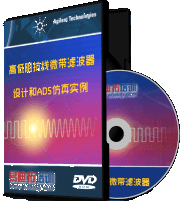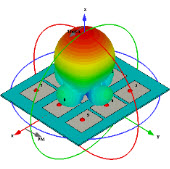CST MWS仿真超宽带UWB天线时,频率范围应该怎么设置?
CST时域求解器,你可以设置最低频率/1.3和最高频率×1.3作为CST设置中frequency的区间。
建议你设置为0-12,再手动加密一部分网格
我想问一下,有些人说最低频率设为0,可以减少仿真时间。但是我看到很多教程,包括论坛里面的几个精华贴里面都说是F1/1.3-F2*1.3...
这个能不能解释一下,哪个好。或者是对应不同的情况进行相应设置
具体问题需要具体分析。
关于0频的解释,请仔细阅读CST MWS帮助文件《Transient Solver Performance Improvements》:
for models without a cut-off frequency (e.g. TEM and microstrip structures), DC should always be included in the frequency range since it shortens the excitation pulse by a factor of 2. For instance, the excitation time for a frequency range 0.01 ... 10 GHz is twice as long as for a range 0 ... 10 GHz.
请注意这个是有条件的,模型不存在截至频率,或者说,在仿真频段中不包括截至频率,这个时候加入0频可以缩短一半的Excitation Time。
Fmin/1.3 - Fmax*1.3是通常建议的设置方法,没有特别的条件限制。
如果你感兴趣的频段是3.1-10.6 GHz,并且不包含截至频率,那么仿真频率设置为0-13 GHz应该可以很好的缩短仿真时间。
假设感兴趣的频段是30 - 50 GHz,那么包括0频就没什么意义了。
谢谢hefang的回答!
我看了一下帮助文档,有一个疑问,增加频段会不会影响到最终结果的精度?
当然增加频段有个方面必然影响:从时域到频段结果的FFT变换,如果没有增加采样点数,所关心频段内的曲线的点数肯定会相应减少。这个是小问题,文档上也说了可以增加采样点数,因为这个不会耗费多少时间的。
我关心的还是上面说的计算进度的问题。改变频段,时域的激励信号会有相应的改变,这样不会影响最终结果吗?
还有你说的30-50GHz包括0频就没有什么意义(假设改变频段不会影响精度),我计算0-55GHz的频率范围如果能有效的减少计算时间为什么就没有意义了呢?顶多我在FFT变换的时候增加3被的采样点数,而且这个应该不会花多少时间的吧。
话可有些啰嗦,希望能读得下去,呵呵
首先,你没有定义“精度”,所以我不能确定你所说的“精度”具体是指什么。
CST MWS帮助文件《Frequency Range Settings》:It is important to know that these settings have some influence on the calculation results, that is why you have to choose Fmin and Fmax properly.
这段文字说频率设置对仿真结果有影响,要设置适合的频率范围,至于这个影响是不是影响你所说的“精度”我不得而知。
如果你所说的“精度”是指准确度,那么最影响准确度的设置是网格划分。只不过,提高最高仿真频率会增加网格数并减小最小网格尺寸,这会导致仿真结果“变化”。因此,不建议设置过高的频率上限,这样既增加网格数,又有可能包括进谐振频率点。
如果仿真波导模型,最小频率应该高于波导的截至频率(cut-off frequency),避免不必要的仿真时间。
以上在CST MWS帮助文件《Signals in Time Domain Simulations》中有描述:The choice of the bandwidth to be simulated may have a strong influence on the simulation time. ... Therefore, the best input signal is one that covers the entire frequency range up to the maximum frequency of interest. Do not increase the frequency beyond what you are interested in because this would lead to more mesh points and a smaller time step. Also, for waveguides, you should (if possible) try to choose the frequency above the cut-off frequency of the modes of interest because around cut off there are very slow-traveling waves that again take a long time to simulate.
综上,重复4楼的开始,具体问题需要具体分析。
如果我感兴趣的频段是30-50 GHz,20 GHz的带宽已经使得excitation time够短的了,我看不出再包括0-30 GHz的任何必要性。
并且,对于谐振结构,缩短excitation time不会对仿真时间带来显著的影响,因为主要的仿真时间在transient time上。对于非谐振结构,也并不是所有的结构都可以通过缩短excitation time节省时间,具体请仔细阅读CST MWS帮助文件《Transient Solver Performance Improvements》:However, if t_end is determined by the transit time of the signals, reducing t1 is not very efficient. That means that if the propagating pulse arrives at the output long after the excitation signal has vanished, the reduction of t1 will not influence the total time t_end significantly.
相关文章:
- 求助:超宽带天线的方案仿真 (05-08)
- 有没有超宽带的二端口隔离器? (05-08)
- CST MWS制作一个带孔椭圆盘超宽带单极天线 (05-08)
- 有没有谁有超宽带天线(平面单极子)的仿真教程啊 (05-08)
- cst仿真错误提示,请求帮助 (05-08)
- 关于偶极子天线仿真的问题 (05-08)











